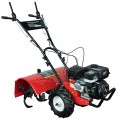Number of blades
The number of cutters that the two-wheel tractor is equipped with. Note that for models with active rototillers (see below), this parameter is not indicated: such attachments are removable, and active rototillers with different performance characteristics can be installed on one unit.
Speaking of quantity, a cutter means a separate "asterisk" of several curved knives installed on the working axis of the unit. The number of such “stars” is selected depending on the processing width that the manufacturer wants to provide: one cutter captures a strip on average from 12 to 18 cm, and several of them are needed for a more or less decent working width.
Speed rotation
The speed of rotation of the cutters provided by the two-wheel tractor in normal operation. For models with several gears and, accordingly, several speed options, this paragraph usually gives the maximum speed.
The value of this parameter directly depends on the type of cutter used in the two-wheel tractor. In models with active rototillers (see below), only the intensity of cultivation and the degree of crushing of the soil depend on the rotation speed; it is believed that it should be at least 270 – 280 rpm. And in motor cultivators, where the cutter is installed on the power axis of the unit (the so-called axial structure), the overall speed of movement will also depend on its speed — and it should not be too high, otherwise the user simply will not keep up with the unit. In such models, manufacturers select the rotation speed depending on the diameter of the cutter so that the speed of the machine in the end is less than 6 – 7 km/h. Therefore, in large motor cultivators, the rotation speed usually does not exceed 130 rpm, and in compact battery models with small diameter cutters, it can reach 300 rpm and even more.
Motor model
Model of the engine installed in the two-wheel tractor / cultivator. The main performance data of the engine is usually indicated in the general data for the unit. However, knowing the exact name of the motor, you can find more detailed information on it — starting from specific data like torque or revolutions and ending with reviews and reviews. Also, data on the engine model can be useful when searching for spare parts or consumables.
Fuel consumption
The average amount of fuel consumed by the gasoline or diesel engine (see "Engine type") of the cultivator/two-wheel tractor per hour of operation. This value is rather conditional, because depending on the mode of operation, fuel consumption may vary in one direction or another; however, in general, it provides an estimate of the approximate amount of fuel required for a given operating time.
Wheels diameter
The diameter of the main wheels of the two-wheel tractor / cultivator. For flat areas, a small diameter is enough, and for difficult terrain, large wheels are better suited — they are much easier to cope with pits, bumps and various obstacles.

